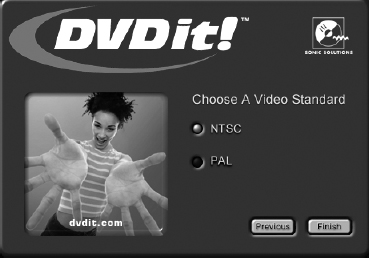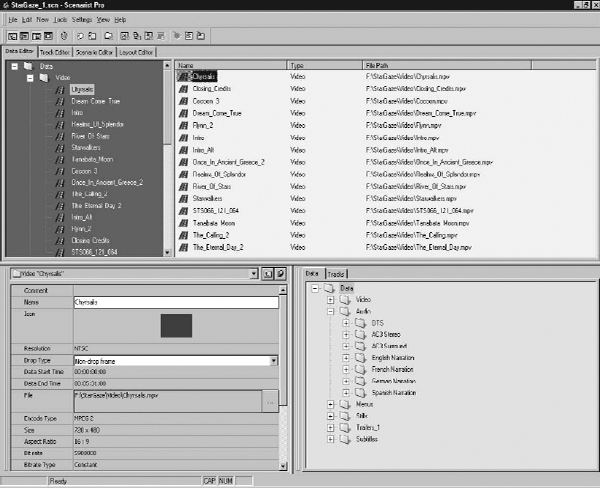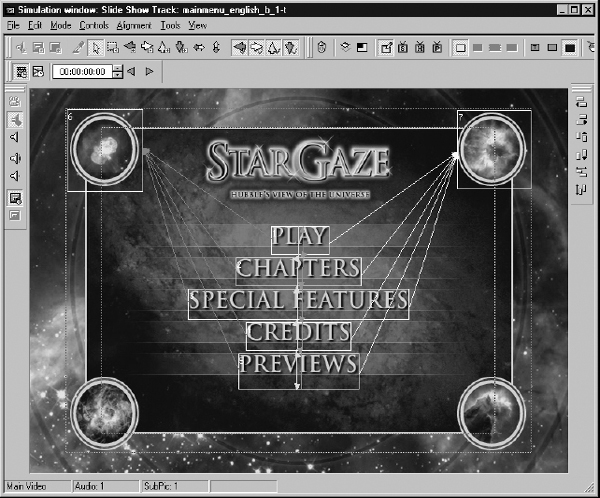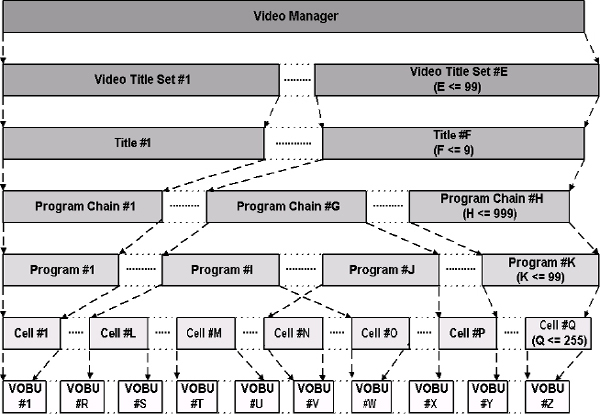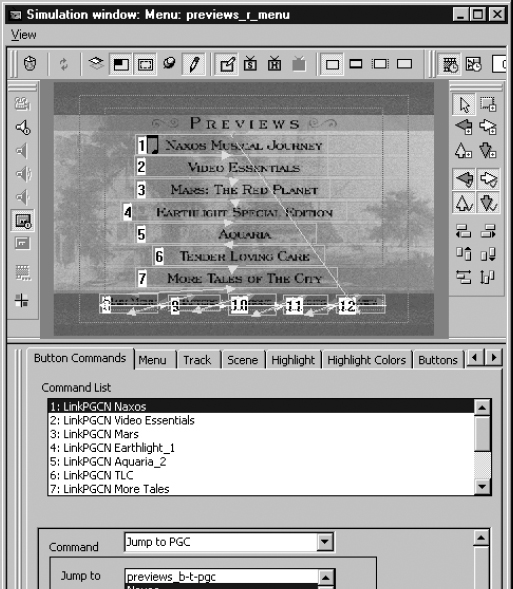MID-RANGE DVD AUTHORING
This chapter will discuss mid-range DVD-Video authoring systems and techniques. Mid-range DVD-Video production systems, as shown in Figure 5.1, try to strike a balance between quality, efficiency, and cost. Mid-range DVD-Video production systems are designed to support the internal development requirements of a large or mid-size company, which generally also has internal video and audio production systems. Thus the DVD production process is simply an extension of the video production process, and DVD-Video is just another media for delivering the desired message. Mid-range DVD-Video titles often have the same high level of production qualities as titles produced on professional systems, but generally they are targeted at a very different set of viewers. Professional DVD production systems are used to create consumer DVD titles, typically from content created in Hollywood. Mid-range DVD production systems are used to create limited distribution DVD titles, typically from content created outside Hollywood.
Mid-range DVD production systems are generally less complex and less expensive than professional production systems. This does not mean that they are not capable of delivering the same level of quality as a professional system, but in general a mid-range production system can’t sustain the same level of workflow as a professional system. In a mid-range production system digital or analog tape decks, typically Digital Beta or BetaSp, deliver video and audio signals to a single workstation that creates encoded MPEG video and Dolby Digital or PCM audio streams. A separate graphics workstation is used to create the menu background and overlay graphics, as well as any required subpicture elements. The MPEG/AC3 workstation and the graphics workstation are usually connected to a DVD-Video authoring workstation by a high-speed network. The DVD authoring workstation includes one or more external hard drives, a DVD-R or DVD-RW recorder, and a DLT tape drive. It’s also connected to video and audio monitoring equipment, used to verify the quality and performance of the DVD title.
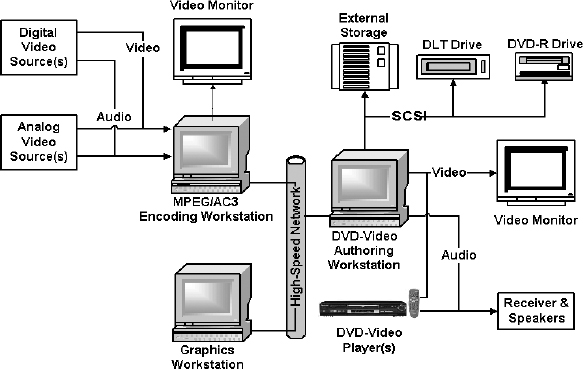
Figure 5.1 Mid-Range DVD-Video Authoring System
The components of a mid-range authoring system can be spread among several different departments within a single organization. For example the graphics workstation might reside in the Graphics Department, the MPEG/AC3 workstation could be in the A/V Department, while the DVD-Video authoring workstation could be located in the Programming Department. Alternatively all three workstations could be located in the same room, and simply be staffed by employees from different departments.
To reduce the cost of a mid-range DVD production system, many components found in professional systems are generally left out. These “optional” items can be included in a mid-range production system if there is sufficient budget, facilities, and staff for them. However most mid-range DVD production systems do not include a DTS encoder, DVNR, dedicated server, and a separate QA/QC workstation. Since the mid-range production system has a distributed architecture as well as a high-speed network, it is possible to upgrade them to support higher workloads, and to provide improvements in overall quality.
Mid-Range DVD Authoring Process
Figure 5.2 shows a block diagram of the mid-range DVD-Video authoring process. As outlined in Chapter 3 this process includes three major areas: Media Identification, Media Association, and Media Organization. One of the major differences between mid-range and entry-level DVD authoring systems is the ability to develop complex as well as highly interactive titles. Mid-range authoring tools will support the use of multiple title sets, multiple program chains, multiple audio tracks, multiple video camera angles, and multiple subpicture streams, while the entry-level tools provided only a bare minimum of DVD-Video features.

Figure 5.2 The DVD-Video Authoring Process
Generally most mid-range DVD-Video authoring systems are designed to support the concept of a DVD project or scenario. Each unique DVD-Video title is associated with a unique project or scenario within the DVD-Video authoring tool. Typically you can only work on one project or scenario at a time, and most authoring tools provide very limited abilities to copy and paste data or structures from one project to another. Some professional tools offer some “template” functions, which can be beneficial when you are developing a series of DVD-Video titles that have the same basic design.
When you start a new DVD-Video project you will enter a number of key parameters about the project so that the authoring system can process each media element correctly. Depending on the sophistication of your authoring tool this can be a simple or a fairly complex process. For example, defining a new project in Scenarist requires setting more than 40 different parameters using 12 different screens. Conversely, defining a new project using Sonic Solutions DVDit! requires setting only 1 parameter on a single screen. Figure 5.3 shows the screens used by Scenarist NT to enter the parameters for a new project. Figure 5.4 shows the new project setup screen for DVDit!.
Figure 5.3 Scenarist Project Wizard Screens (See color insert for color version of this figure and Figure 5.4 below.)
Figure 5.4 Sonic Solutions DVDit! New Project Screen
The type of information to be defined for each new DVD project or scenario includes the following.
Project or Scenario Name This information is used by the DVD-Video authoring system to keep track of a project and all its media assets. Some DVD-Video authoring systems will also use the project or scenario name to create the volume name for the final disc image.
DVD Type Define the type of content that will go on the DVD disc including DVD-Video, DVD-Audio, DVDROM, Hybrid, or WebDVD.
DVD Disc Information Define the type of DVD disc to be created. This includes the size of the disc (DVD-5, DVD-9, DVD-10, DVD-14, or DVD-18) and, if the disc will be dual layered, whether it use the parallel track or opposite track configuration.
Video Format Define the type of video content to be used throughout the disc including aspect ratio (4:3 Pan/Scan, 4:3 Letterbox, and 16:9) as well as the television standard (NTSC or PAL).
Subpicture Conversion Colors Define the default values for the four subpicture colors (BG, P, E1, and E2). While these values can usually be changed in the authoring software once the project has been created, these initial values will be used to automatically convert any subpicture and menu overlay graphics used in the project.
Default Color Palette Define the default values for the system color palette. These values can usually be changed in the authoring software once the project has been created.
Subpicture Display Color and Contrast Level Define how the four colors subpicture colors (BG, P, E1, and E2) will be mapped to the color palette, and the transparency level (0*–100%) to be assigned to each color. These values can usually be changed in the authoring software once the project has been created.
Button Display Color and Contrast Level Define how to map the four colors used in a menu overlay graphic (BG, P, E1, and E2) to the color palette, and the transparency level (0-100%) to be assigned to each color. Values must be defined for the unselected, selected, and activated mode for menu buttons. These values can usually be changed in the authoring software once the project has been created.
Video Title Sets Define how many unique video title sets are required for the project. Additional title sets can be defined manually in the authoring system after the project creation step has been completed.
File Locations Define where the authoring software should store work files generated in the DVD disc formatting process, as well as where the final disc image files should be stored.
Templates Many mid-range authoring systems provide the ability to use predefined or custom templates to make the authoring process a little easier and faster. If the current project is similar to a project that has already been completed, it may be possible to use a template to complete the project faster.
Media Identification
As discussed in Chapter 3, Media Identification is the process of telling the DVD-Video authoring system the location and properties of each media element to be used in a DVD project. While the specific methods of importing media elements into a mid-range tool can be quite different from an entry-level tool, the basic concept is the same. One nice feature that is included in most mid-range and professional authoring systems is the ability to organize media elements once they have been identified by the authoring system. Figure 5.5 shows the Data Editor screen of Scenarist 2.5. As you can see from this figure Scenarist allows you to create custom folders to organize media elements, and it also allows you to manually set all of the important parameters for each media element. The ability to organize media elements once they have been brought into the authoring tool is of critical importance when you start to work on larger and more complicated titles. DVD titles can easily have hundreds, if not thousands, of unique media elements, and it is very difficult to work with an authoring tool that does not allow these elements to be organized in a logical fashion.
Tips, Tricks & Techniques
It is a good idea to define standard RGB values for all subpicture and menu overlay colors (BG, P, E1, and E2). Using the same RGB values on all your projects will make it a lot easier and faster to author DVD titles. It is also a good idea to use primary colors for each of the four subpicture colors. Some easy colors to work with are Blue (RGB=0,0,255), Green (RGB=0,255,0), Red (RGB=255,0,0), White (RGB=255,255,255), and Black (RGB=0,0,0). Since these will not actually be displayed on the monitor it is acceptable to use colors that are outside the NTSC Color Safe range.
Video Elements
Most mid-range authoring tools will accept video in the MPEG-1 or MPEG-2 formats, while some will also accept uncompressed QuickTime (.mov) or Video for Windows (.avi) files and transcode them into the MPEG format (.mpv). When MPEG video files are dropped into the authoring tool the file is analyzed to determine its compression parameters and the location of the I frames so that chapter points can be added if needed. There are a number of compression parameters that can be automatically detected from the MPEG file.
• Video Format (NTSC or PAL)
• Aspect Ratio (4:3 or 16:9)
• Start Time Code
• End Time Code
• File Name and Path
• Resolution (720 480, 704 480, 720 576, 704 576, 352 480, 352 576, 352 240, or 352 288)
• Compressed Bit Rate
• Compression Format (MPEG-1, MPEG-2)
• Compression Method (Constant or Variable)
Figure 5.5 Scenarist Data Editor
Additional parameters may be entered by the developer.
• Media Element Name
• Media Element Location
• Time Code Format (Drop-Frame, Non-Drop Frame)
Figure 5.6 shows that properties of an MPEG video clip are imported into Scenarist, and are ready for use within the project.
Audio Elements
Audio elements used in a DVD-Video title can be in a variety of formats including linear PCM, Dolby Digital, DTS, MPEG, and SDDS. Linear PCM audio files generally end in .wav or .aiff extensions. Dolby Digital files usually end with the .ac3 extension, while DTS files can end in either a .dts or a .cpt extension. MPEG audio files can end with either the .mpa or .mpg extension. When an audio file is dropped into most DVD authoring tools, the file is analyzed to determine its encoding parameters.
A number of encoding parameters can be automatically detected from the file.
• Start Time Code
• End Time Code
• File Name and Path
• Audio Format (PCM, Dolby Digital, DTS, or SDDS)
• Bit Rate
• Number of Channels
• Quantization Level (16, 20, or 24 bit)
• Sample Rate (48 KHz or 96 KHz)
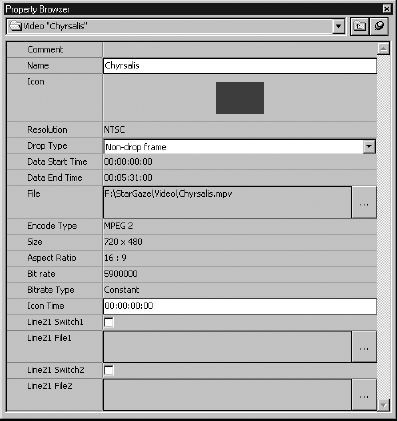
Figure 5.6 Scenarist Video Element Properties
Additional parameters may be entered by the developer.
• Media Element Name
• Video Format (NTSC or PAL)
• Time Code Format (Drop Frame or Non-Drop Frame)
• Emphasis, Mute, and Dynamic Range Settings
Figure 5.7 shows the properties of a linear PCM audio clip imported into Scenarist. As you can see from the figure, all of the important compression and audio format parameters are available for use by the authoring tool.
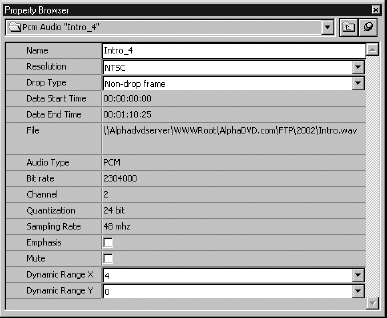
Figure 5.7 Scenarist Audio Element Properties Display
All still image elements used in a DVD-Video title are stored as MPEG I frames. Typically the authoring system will perform the required MPEG compression. Most authoring tools will accept still images or graphics in a variety of formats, such as TIF and BMP. It is a good idea to used uncompressed versions of these graphic file formats to maximize the quality of the final DVD title. When still images are dropped into the authoring tool there are a number of key parameters that can automatically be determined from the graphic file.
• File Name and Location
• Image Resolution Size
Additional parameters may be entered by the developer.
• Media Element Name
• Video Format (NTSC or PAL)
• MPEG Encoding Format (MPEG-1 or MPEG-2)
• Compression Bit Rate
• Compressed Image Resolution Size

Figure 5.8 Sonic Scenarist Still Image Properties
Figure 5.8 shows the properties of a still image imported into Scenarist. As you can see from the figure all of the important compression and image format parameters are available for use by the authoring tool.
Subpicture Elements
Subpicture elements are static graphics used for subtitles or menu highlights. All subpicture elements used in a DVD-Video title are stored as run-length coded bitmaps. Authoring systems will automatically convert each subpicture element into a run-length coded bitmap. As with still images most authoring tools can accept subpicture elements in either the TIF or BMP format. When subpicture elements are dropped into the authoring tool, a number of key parameters can automatically be determined from the graphic file.
• File Name and Location
• Image Resolution Size
Additional parameters may be entered by the developer.
• Media Element Name
• MPEG encoding format (MPEG-1 or MPEG-2)
• Compression Bit Rate
• Compressed Image Resolution Size
• Forced or Non-Forced Start
• Color Conversion Rules
• DCS Stream Information
Figure 5.9 shows the properties of a subpicture element imported into Scenarist. As you can see from the figure all of the important compression and image format parameters are available for use by the authoring tool.

Figure 5.9 Scenarist Subpicture Element Properties Display
Media Association
Once the media elements have been identified by the authoring system, and the various parameters associated with each element have either been automatically detected or manually entered, you can start the process of combining media elements to form media tracks. A media track is a combination of video, audio, subpicture, and still image elements that are displayed by the DVD-Video player. There are three basic kinds of media tracks that can be used in a DVD title: video tracks, still tracks, and menu tracks.
Video Tracks
Video tracks are by far the most common track type used in a DVD title. They consist of at least one video camera angle. As many as nine video camera angles, eight audio streams, and 32 subpicture streams can be included in a single video track, although it is rare to see a track with the maximum number of camera angles, audio tracks, and subpicture streams. Most DVD-Video authoring tools use a time-line display to associate the video, audio, and subpicture elements to form a video track.
Subpicture streams are formed by the combination of one or more subtitle elements, which are synchronized to the video through the use of start and stop time codes. Subpicture elements can also have special effects, such as fades or wipes, associated with them and triggered at specific time codes. Subpicture streams have aspect ratio parameters associated with them to tell the DVD-Video player if the stream should be used in normal, letterbox, or wide-screen display modes.
Video tracks can also have scene indexes defined to allow direct access to a specific time code in the video. Most authoring tools will allow you to place a scene index at an MPEG I frame location. Some authoring tools will create an I frame if one does not already exist at the desired scene index point.
A sample video track is shown in Figure 5.10, with a single video camera angle, seven audio streams, and eight subpicture streams.
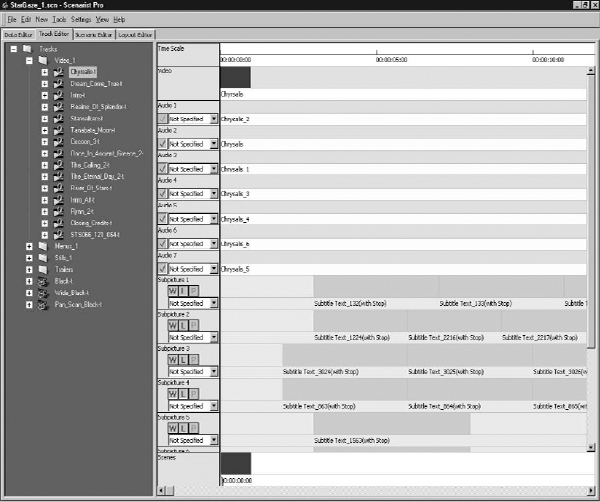
Figure 5.10 Scenarist Video Track Display
Audio and subpicture streams can have languages associated with them, which are used to identify the spoken or written language of a specific audio or subpicture stream. Table 5.1 lists the different languages that can be used to identify audio or subpicture streams. Many title developers choose to set the languages for audio and subpicture streams as Not Specified. This is primarily due to compatibility problems with older DVD-Video players and DVD-ROM decoders that can’t interpret language codes correctly. Many mid-range and entry-level DVD authoring systems don’t support the full range of languages for menus, audio, and subpicture streams.
Table 5.1 Valid DVD-Video Audio, Menu, and Subpicture Languages
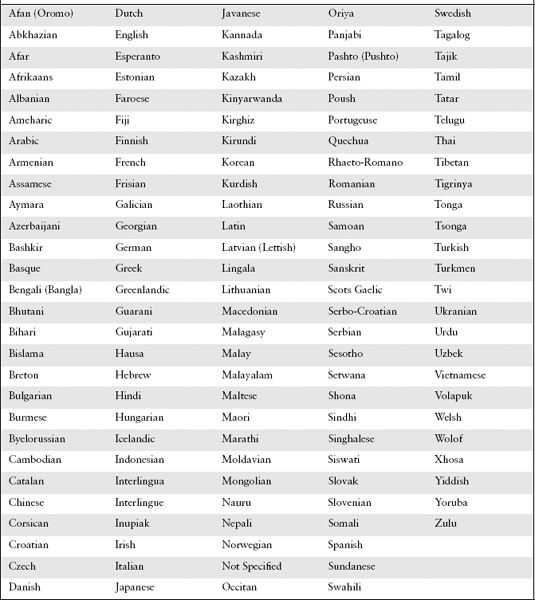
Still Image Tracks
Still images can be presented individually or in a predefined series. Individual still images can be displayed on a timed basis, with a minimum display time of 0.4 seconds, or they can be displayed indefinitely until a specific user operation is initiated. Still show tracks can only include still images, with no accompanying audio or subpicture streams.
Real World Example
StarGaze has ten distinct video tracks, or chapters. Each of these video tracks includes seven audio streams (Dolby Digital 5.1 music, DTS music, Dolby Digital 2.0 music, English narration, French narration, German narration, and Spanish narration) as well as eight subpicture streams (English, French, German, and Spanish subtitles and English, French, German, and Spanish nomenclature). Over 4,000 unique media elements (video, audio, and subpicture) were required to create these 10 video tracks.
A slide show track is similar to a still show track with the exception that it can include audio and subpicture streams. Slide show tracks can’t include additional camera angles, and the minimum amount of time that a single still image can be displayed is 0.4 seconds. If one or more audio streams are present in a slide show track, the presentation length of the still images must be less than or equal to the length of the shortest audio stream.
There are a number of DVD-ROM enabled personal computers that have problems playing back still show and slide show tracks. Some of these systems will display each still image for a fraction of a second, and then jump to the next image in the sequence, essentially ignoring the display time data authored into the DVD-Video disc. In Figure 5.11 a sample slide show track is shown with a single still image and an associated subpicture stream.
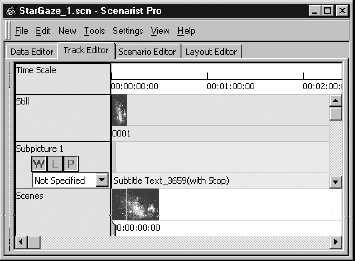
Figure 5.11 Scenarist Slide Show Track with Still Image and Subpicture Stream

Real World Example
StarGaze includes a “DVD-Video Screen Saver” mode that display over 140 different still images in a random order. Each of these still images was created as a slide show with eight subpicture streams, but no audio. To activate the DVD-Video screen saver mode of StarGaze go to the Special Features Menu, select the Screen Saver Menu and then select the DVD-Video Screen Saver button.
Menus are created in much the same way that a video track or a still image track is created, except that there is an extra layer of information associated with the menu buttons. This is generally called the Highlight layer and it is used to define the size, color and display properties of buttons on the menu. Static menus have still images as their background graphics while motion menus use video clips in the background. Static and motion menus can include a single audio stream, and up to three subpicture streams, which are used to create the button highlights. Not all mid-range authoring tools will support the use of multiple aspect ratio menus, or the use of a video background to create a motion menu.
Depending on your authoring tool there can be several steps in the process of creating a menu.
1. Create an empty menu track.
2. Add a still image or video clip as a background.
3. Add an audio stream if required.
4. Define the playback stop time if required.
5. Create one, two, or three subpicture streams as required. Each subpicture stream can be used to define highlight information for a specific display mode (4:3 normal, 4:3 letterbox, and 16:9 widescreen).
6. Insert the appropriate subpicture graphic into each subpicture stream.
7. Define the size and location of the menu buttons for each display mode.
8. Create the Up, Down, Left, and Right navigational links for each button in each display mode.
9. Define the default button to be enabled when the menu is first accessed.
Menus that include audio or video elements will only be displayed until the user takes action or when the audio or video element ends. Figure 5.12 shows a menu track with a still image background, a single subpicture stream, and the highlight stream that contains the button information.

Figure 5.12 Scenarist Menu Track
Figure 5.13 shows the buttons and navigation commands for this sample menu track. In this example there are a total of five menu buttons defined, aligned vertically. The arrows indicate that an UP and Down navigation command has been programmed for each button. This menu uses a “wrap-around” navigation scheme. Since all the buttons are aligned vertically, this menu does not make use of the Left and Right navigation commands.
Figure 5.13 Scenarist Menu Buttons and Navigation Information (See color insert for color version of this figure.)
DVD menu buttons can only be square or rectangular in shape. While it is possible to overlap buttons, it is not recommended since this may result in strange menu behavior on some DVD-Video players, or DVD-ROM computers.
It is possible to create “hidden” buttons on a menu by defining a button in an area where there is no P, E1, or E2 color on the subpicture graphic. Figure 5.14 shows a menu with two hidden buttons, located at the top left and top right of the menu. To select the hidden buttons the user simply has to press the Left or Right keys on the remote control. In this example the two hidden buttons have been given a “forced activate” property — once the button is selected, it will also be activated. Using a forced activation property for a hidden button will prevent the user from being confused by a menu where no specific button is selected.
For DVD-Video menus that use a single aspect ratio there can be up to 36 different buttons defined on a single menu. Menus with two aspect ratios have two groups of 18 buttons, with one group for each display mode. For menus with three aspect ratios there are three groups of 12 buttons defined. This concept of menu button groups is fairly difficult for some people to grasp, and in general only advanced DVD title developers will need to work with them. The key thing to remember is the maximum number of buttons for menus with 1, 2, or 3 different aspect ratios. Human factors engineers will tell you that menus should have seven buttons or less to make them easy to use, so in most cases having three button groups of 12 buttons is not a limitation for implementing a DVD-Video title.
Figure 5.14 Menu with “Hidden” Buttons (See color insert for color version of this figure.)

Real World Example
All menus on the StarGaze disc are designed to provide simple and immediate feedback to the viewer. Selected buttons are indicated by the presence of a white line under the button. When a button is activated the white line changes to gold while the DVD-Video player is executing the appropriate button command. There are two hidden buttons on the Main Menu that have forced-activation properties. Press the Left key while on the Main Menu and StarGaze will set a loop mode flag so the main program is played forever. Press the Right key while on the Main Menu and a bonus video track is displayed. A hidden button on the DVD Production Credits Menu will play an “Easter Egg” track with video of Mount St. Helens (after the explosion).
Media Organization is the process of defining the playback order for all of the video, still show, slide show, and menu tracks on the disc, as well as programming the operation of each menu button. Most mid-range DVD-Video authoring tools use a flow chart metaphor to allow the developer to organize media elements into a functional DVD title, although some DVD tools use a timeline metaphor. In either case the goal of this step is simply to tell the authoring tool how to organize all of the media tracks to create the desired flow and operation of the DVD title.
Most mid-range authoring tools use terminology defined in the DVD-Video specification, such as Video Manager, Video Title Set, Program Chain, Program, and Cell. Mid-range authoring tools, from Spruce and Apple, hide these DVD-Video specification details and use terminology such as Title, Menu, Chapter, and Scene. Each authoring tool is unique so it is important to understand the terminology used by your tool and how those terms relate to the media elements and constructs allowed for DVD-Video titles.
Since the terminology used by DVD-Video authoring tools can be quite different, I will use the standard terms defined in the DVD-Video specification when I talk about DVD-Video authoring.
![]()
Tips, Tricks & Techniques
While it is not essential to understand how DVD-Video titles are organized in order to author them, it can be very beneficial. I have found using an analogy of a book helps most people understand the hierarchical organization of DVD-Video. If we ignore how books are published and concentrate on how they are organized we can see the following hierarchical structure.
Library
Book(s)
Chapter(s)
Paragraph(s)
Sentence(s)
Word(s)
Letter(s)
This organizational structure is independent of publishing medium and language. Using the structure of books to understand the structure of DVD-Video titles yields the following analogy:
Video Manager
Video Title Set(s)
Title(s)
Program Chain(s)
Program(s)
Cell(s)
VOBU(s)
DVD-Video titles can include several domains and spaces. Domains and spaces are logical constructs that help to understand how media elements are organized on a DVD title, and how they can be presented to the viewer. Figure 5.15 shows the possible domains and spaces that can be found on a DVDVideo title. Some domains and spaces are optional, while others are mandatory. There are restrictions on movement directly between certain domains and spaces. To control the flow of a title you need to understand how to move from one domain or space to another.
Mid-range authoring tools from Spruce and Apple hide the concept of domains from the title developer. While this simplifies the authoring process, it also creates inherent limitations in the authoring tool. For example, DVD Studio Pro stores each video segment in its own Video Title Set, thus the maximum number of video segments in a project is limited to 99. Scenarist provides full access to all domains defined by the DVD-Video specification, so it can include over 98,000 unique video segments in a project. Providing the title developer access to all of the domains and spaces defined in the DVD-Video specification will require some additional knowledge to use these features to their full extent. Therefore mid-range authoring tools that provide access to domains and spaces are generally more difficult to use than tools that hide this level of the DVD-Video specification from the title developer.

Figure 5.15 DVD-Video Domains & Spaces
The Title Domain generally includes all of the media elements to be presented to the viewer. A DVD disc can have as many as 99 different Title Domains, and each title can include up to 999 program chains. Program chains can be made up of a single media track, or multiple media tracks. If the Title Domain includes just one program chain, then it is called a “One_Sequential_PGC” title, which means that the DVD-Video player will have access to time-table information during playback of that PGC. If you want the viewer to see a time display on their DVD-Video player front panel, you will need to author your discs using “One_Sequential_PGC” titles. Some entry-level systems can only create “One_Sequential_PGC” titles if there is only a single media element used in the title. If more than one media element is used, these entry-level systems create DVD titles with multiple PGC’s, and so most DVD-Video players will not display playback time information.
It is possible to include any type of media track (video, still show, slide show, and menu) in the Title Domain. While most DVD-Video title developers place all their menus in the Video Manager Domain or the Video Title Set Menu Domain, there are times when it may be necessary to include menus in the Title Domain. Placing menu tracks in the Title Domain will be discussed in detail in Chapter 6.
Menu Space
The Menu Space includes all items stored in the Video Manager Domain and the Video Title Set Menu Domain. It is fairly easy to move from an element stored in the Video Title Set Menu Domain to an element in the Video Manager Domain. Moving from an element in the Video Manager Domain to an element in the Video Title Set Menu Domain is limited to the Root, Angle, Audio, Chapter, and Subpicture Menus.
While it is possible to create a DVD-Video title that has no items in the menu space, this is not recommended. DVD titles that have no menus are little better than linear VHS titles, and will not be seen favorably by consumers.
Video Title Set Space
The Video Title Set Space includes all items stored in the Video Title Set Domain and the Title Domain within the same Video Title Set. Movement within the Video Title Set Space is fairly easy. It is possible to jump directly from any program chain in the Video Title Set Menu Domain to any program chain in the Title Domain, and vice versa. It is not possible to jump directly from a program chain in either the Video Title Set Menu or Title Domains to a program chain in a different Video Title Set. If you need to jump from a program chain in one Video Title Set to a program chain in another Video Title Set, you will have to do it indirectly through program chains located in the Video Manager Domain. The concept of indirect jumping will be discussed in more detail in Chapter 6.
First Play Domain
The First Play Domain is optional and contains a single program chain that can’t include any media elements. This is called the First Play PGC in most authoring tools. Whenever a DVDVideo player is turned on or a new disc is inserted, control automatically passes to the First Play PGC. Essentially this is a standard method to bootstrap a title so that it starts playing automatically when it is inserted into a DVD-Video player. While the First Play PGC is optional, I strongly recommend that you include one on every DVD title you develop. If you do not include a First Play PGC, some consumers will be confused when they insert your DVD title into their DVD-Video player and nothing happens. On many entry-level DVDVideo authoring systems the use of a First Play PGC is mandatory.
When using a First Play PGC you must include a Pre or Post Command to instruct the DVD-Video player where to jump at the end of the First Play PGC. You can only jump directly to the entry point of a Video Title Set or to another program chain within the System Space from the First Play PGC. Chapter 6 will discuss Pre and Post Commands in more detail.
![]()
Tips, Tricks & Techniques
The First Play PGC should only be played when a DVD disc is first inserted into the player, or when the player is turned on with a disc already in it. Generally the First Play PGC is used to start playback of a sequence of media elements that only need to be viewed once, such as an FBI warning or company logos. Some title developers have created DVD titles in which pressing the Title or Menu key forces the DVD-Video player to jump to the First Play PGC. In general this is not a good design practice as the Title and Menu keys have specific functions that are different from the First Play PGC.
Video Manager Menu Domain
The Video Manager Domain stores the disc’s Title Menu(s). While most DVD-Video discs have only one Title Menu, it is possible to create a disc with a large number of Title Menus, each with their own unique language. When the viewer presses the Title button on their remote control the DVD-Video player will locate the appropriate Title Menu program chain in the Video Manager Domain, based on the default language setting of the DVD-Video player. As with the First Play PGC, the use of a Title Menu is optional. However I strongly recommend that you include one on every DVD title you develop. If you do not include a Title Menu, some consumers will be confused when they press the Title button on their remote control and nothing happens. Note that on some DVD-Video players the Title Menu button is labeled as “Top Menu”.
It is a common practice, to include some video, still show, or slide show tracks in the Video Manager Domain. Generally media elements like an FBI warning screen and the distributors logos are included in the Video Manager Domain since they can be directly linked to from the First Play PGC. Media tracks stored in the Video Manager Domain can’t be directly accessed from the DVD-Video player’s remote control using the Title and Chapter number keys. Thus if you want to include hidden content, such as Easter Egg tracks, the Video Manager Domain is a good place to hide these tracks.
Video Title Set Menu Domain
The Video Title Set Menu Domain stores the disc’s Root, Angle, Audio, Chapter, and subpicture Menus. These menus are all optional, and as with the Title Menu there can be multiple copies of each menu with different languages. Some DVD-Video players will allow the viewer to press a combination of keys to directly access these menus. For example on some players pressing the Audio and Menu buttons will cause the player to jump directly to the audio menu, while pressing the Angle and Menu buttons results in the angle menu being displayed, if it exists. Unfortunately many players don’t work this way, and most consumers are not aware that pressing two buttons at once will yield different results from pressing the same two buttons in sequence. If you choose to use Angle, Audio, Chapter, and Subpicture Menus in the Video Title Set Domain, make sure that these menus are accessible from buttons on the Title Menu or Root Menu of the disc.
System Space
The System Space includes all elements stored in the First Play Domain, the Video Manager Domain, and the Video Title Set Menu Domain. Movement between the elements in the System Space is possible in several different ways, including both direct and indirect jumping.
Organizational Elements
If you want to develop only simple DVD-Video titles there is no compelling reason for you to understand the hierarchy of DVD-Video titles as defined by the DVD-Video specification, and there are a number of excellent authoring tools that will allow you to quickly and efficiently develop mid-range DVD-Video titles. However if you want to develop advanced DVD-Video titles or take advantage of DVD-Video features such as multi-angle video or multiple language menus, then you will need to understand how DVD-Video was designed to handle these advanced features. You will also need to use a mid-range or professional authoring tool that will allow you to use all the features of the DVD-Video specification. DVD-Video titles are organized into a hierarchical structure with seven distinct levels, as shown in Figure 5.16.
Many DVD-Video authoring tools hide some of the lower levels of this hierarchy to simplify the authoring process.
Video Object Unit (VOBU)
A VOBU is the smallest unit of multimedia content stored on a DVD disc, and holds between 0.4 and 1.2 second of video data. Most VOBUs hold exactly one GOP of video data, but there are some special cases in which they can hold slightly more. DVD-Video authoring systems will convert all multimedia data (video, audio, and images) into VOBUs so the DVDVideo title developer generally does not have to work at this lowest level of the organizational hierarchy.
Cell
A Cell is a combination of VOBUs that forms the basic unit of media presented to the viewer. Cells include video, audio, still images, and Pre and Post Commands to provide control of navigation both before and after a Cell is played. More than one program, or program chain can share cells.
Figure 5.16 The DVD-Video Organizational Hierarchy
Program
A program is a collection of up to 255 cells, which can be presented to the viewer in a seamless fashion. For video tracks, programs can be equivalent to individual scenes defined in the track. Through the use of Pre and Post Commands as well as menu button commands it is possible to jump directly to the start of a program. For movies published on DVD-Video, each scene is generally assigned to a program so that the viewer can jump directly to the start of the scene.
Program Chain
A Program Chain is a collection of up to 99 programs, which can be presented to the viewer in a seamless fashion. For movies published on DVD-Video the entire length of the film is generally stored in a single program chain with as many as 99 programs used to provide random access to scene index points. Program chains can also be used to hold still shows, slide shows, and menus. Through the use of Pre and Post Commands as well as menu button commands it is possible to jump directly to the start of any program within a program chain, as long as the command is executed internally to the program chain.
Title
A Title is a collection of up to 999 program chains, which can be accessed through the use of Pre and Post Commands as well as menu button commands. Any program chain or program defined in a Title can be accessed directly from within that Title. One program chain in each Title is defined as the Entry PGC, which can be accessed directly from the Video Manager Domain. Titles with a single program chain are called One_Sequential_PGC, while titles with more than one program chain are called Non_Sequential_PGC titles.
Video Title Set
A Video Title Set is a collection of up to nine titles defined in the Video Title Set Menu Domain. Any program chain or program defined in any Title within the Video Title Set can be accessed directly from within that Video Title Set Menu Domain. One program chain within the Video Title Set Menu Domain must be designated the Root PGC, and other program chains can be designated as the angle menu, audio menu, Chapter Menu, or Subpicture Menu. If the user presses the Menu key while any of the program chains inside the Video Title Set are being played, control will pass directly to the program chain in the Video Title Set Menu Domain that is designated as the Root Menu. Separate copies of the Root, Angle, Audio, Chapter, and Subpicture Menus can be created with different languages.
Video Manager
The Video Manager is a collection of up to 99 Video Title Sets, as well as program chains defined in the Video Manager Domain. One program chain in the Video Manager Domain is designated as the Title Menu. Separate copies of the Title Menu can be created with different languages. The Video Manager acts as the Table of Contents for all of the data stored on the DVD-Video disc. Direct access from any program chain in the Video Manager is possible to the Angle, Audio, Chapter, Root, and Subpicture Menus and the Title Entry PGC in all Video Title Sets.
Navigation Commands
There are three different types of navigational commands possible using the DVD-Video player remote control. These navigational commands allow the viewer to skip to the next or previous chapter, jump to the previous menu, and control the playback speed and direction of the content. Some of these navigation commands must be programmed into the DVD-Video title by the developer, while others will always work unless specifically prevented by the developer.
Next, Previous & Go-Up
The Next and Previous keys on the remote control allow the user to move between program chains, and between programs within the same program chain. Within a program chain pressing the Next key will instruct the DVD-Video player to jump to the start of the next program. If the Next key is pressed while the last program is being played it will have no effect. Pressing the Previous key within a program chain will instruct the DVD-Video player to jump to the start of the previous program. Many DVD-Video players will jump to the start of the current program when the Previous key is pressed, and to the start of the previous program when the key is pressed twice. It is generally not necessary to program the Next and Previous navigation functions within a program chain that has more than one program.
For Non-Sequential-PGC titles, which are titles with more than one program chain, the Next and Previous keys allow the user to navigate between the various program chains included in the title. While some DVD-Video authoring tools will automatically insert Next and Previous commands when you create multiple program chains in a title, this is generally a manual step that must be performed by the DVD developer. Next and Previous commands can only be created between program chains within a single Title Domain. It is not possible to link program chains in different Title Domains using the Next and Previous commands, nor is it possible to link program chains within the Video Title Set Menu Domain or the Video Manager Domain using Next and Previous commands.
The Go-Up command, called Return on many DVD-Video players, is used to allow the viewer to move between program chains within a Title. Generally the Go-Up command is used to navigate between Menu program chains, while Next and Previous are used to navigate between program chains that hold video, audio, or still image data. Using the Go-Up command to link Menu program chains allows the user to quickly return to a previous menu or a parent menu, although this key can be programmed to jump to any program chain in the title even if it does not contain a menu. The Go-Up command can’t be used to link programs within a program chain to other programs. The Go-Up command can be used in the Video Title Set Menu Domain as well as the Video Manager Domain. Figure 5.17 shows a portion of a DVD-Video title design with program chains connected using the Next, Previous, and Go-Up commands.

Figure 5.17 Next, Previous, and Go-Up Command Examples
In this example a Video Title Set has been created with a single Title, which includes seven program chains with video tracks, one program chain with a menu, and a dummy program chain. The Video Title Set Menu Domain has a single Root Menu program chain. The purpose of this VTS is to present the viewer with previews of seven different DVD-Video titles. The user can select any of the previews from the menu, which is defined as the Title Entry PGC. Once a preview is selected the DVD-Video player jumps directly to the start of that preview and starts playing the video and audio content. When the preview is over control passes back to the Menu PGC. If the viewer decides they don’t want to watch any more of a specific preview they can press the Next, Previous, or Go-Up buttons to be taken directly to the Preview Menu program chain. So in this example, the seven previews program chains are programmed to support the use of the Next, Previous, and Go-Up buttons. The Next and Previous commands are not programmed for the Menu PGC, but it does have a Go-Up command associated with it. If the viewer presses the Go-Up command while the Preview Menu is displayed, the DVD-Video player will jump directly to the Title Menu, which is this menu’s parent menu.
![]()
Tips, Tricks & Techniques
While most DVD-Video titles make use of the Next and Previous commands to allow the viewer to jump between programs and program chains, the use of the Go-Up command is much less prevalent. For DVD-Video titles with complicated menu structures the Go-Up command can provide the viewer with a quick and easy method of going backwards through the menu structure. DVD-Video title developers should program in the Go-Up command on all titles that include multi-level menus.
Menu Buttons
Each button on every menu of a DVD-Video title must be programmed so that the desired effect is achieved when the viewer selects that button and presses the Enter key on the player’s remote control. While there are some very sophisticated things that can be programmed for a menu button, the vast majority of DVD-Video titles have menu buttons that are programmed to jump to a specific program chain when activated. Figure 5.18 shows an example of how menu buttons are programmed. This menu includes buttons to allow the user to return to the Main Menu (Title Menu) or jump directly to any of the other major menus on the title (Chapters, Options, and Credits).
Buttons 1–7 on this sample menu are programmed to jump directly to the seven program chains that contain the different previews. Button 8 is programmed to jump to the Title Menu, button 9 will take the user to the Chapter Menu, button 10 will take the user to the Options menu, button 11 will take the user to the Credits Menu, and button 12 will instruct the DVD-Video player to remain on the Previews Menu with button 1 highlighted. The lines shown connecting the menu buttons are the Left, Right, Up, and Down navigation commands programmed for this menu.
This sample menu is designed without a default button highlight, so that different buttons will be highlighted each time the user returns to the menu. The first time the user sees this menu button 1 will be highlighted. If the user presses button 1, the player will start to play the first preview. When the preview ends or the user presses the Next, Previous, or Go-Up buttons, the Previews Menu will be displayed with the second button highlighted. Every time the user goes to a new menu the button he or she is most likely to use can be highlighted automatically. Including this type of menu button intelligence in your design allows the viewer to navigate through menus and buttons easier and faster. Some DVD-Video authoring systems, such as Spruce DVD-Maestro, can automatically generate the commands necessary to implement this intelligent menu structure, but most systems require the developer to implement a combination of Pre and Post Commands, as well as menu button commands.
Figure 5.18 Sample Menu Button Commands (See color insert for color version of this figure.)
Most DVD-Video players include a variety of playback controls on their remote controls, including Play, Pause, Stop, Fast Forward, and Reverse. In general DVD-Video title developers do not need to program these functions into their title in order to support these keys. In fact unless the DVD-Video developer specifically prohibits these functions the viewer will be able to use these keys to navigate forwards and backwards through the title. Methods for prohibiting the use of playback controls will be discussed in Chapter 6.
Mid-Range DVD Authoring Summary
This chapter has covered the steps required to author a mid-range DVD-Video title. There are at least a dozen different mid-range DVD-Video authoring tools on the market today, and they all have slightly different user interfaces, features, and capabilities. It is not possible to show you exactly how to author a mid-range DVD-Video title for every authoring tool available today. However almost all tools use the same basic steps to complete the authoring process. These steps include the following.
1. Media Identification
a. Import Video Elements
b. Import Audio Elements
c. Import Subpicture Elements
d. Import Still Image & Graphic Elements
2. Media Association
a. Create Video Tracks
b. Create Still Show & Slide Show Tracks
c. Create Menus
3. Media Organization
a. Create First Play PGC
b. Create Video Title Sets
c. Create Titles
d. Create Program Chains
e. Insert Video, Still Show, Slide Show & Menu Tracks into Program Chains
f. Create Next, Previous & Go-Up Navigation Commands
g. Create Title, Root, Angle, Audio, Chapter & Subpicture Menus
h. Program Menu Buttons


